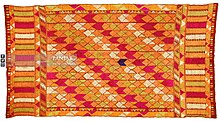
| Part of a series on |
| Punjabis |
|---|
 |
 Punjab portal |

Phulkari (Gurmukhi: ਫੁਲਕਾਰੀ; Shahmukhi: پھلکاری) refers to the folk embroidery of the Punjab region and Gulkari of Sindh in South Asia.[1][2][3]
Although phulkari means 'floral work', the designs include not only flowers but also cover motifs and geometrical shapes.[4] The main characteristics of phulkari embroidery are use of darn stitch on the wrong side of coarse cotton cloth with coloured silken thread.
The traditional varieties of phulkaris are large items of cloth and include chope, tilpatr, neelak, and bagh.[5] Some make the distinction that phulkari only refers to sparingly-embroidered flowers, where the base cloth is still visible, while an intricately embroidered flower pattern that covers the entire garment is known as a bagh ('large garden').[6][7][5]

The craft of phulkari has undergone changes over the centuries. According to Pal (1960), the traditional method of embroidering a phulkari and its widespread use in Punjab, India, declined by the 1950s.[8] Traditionally, women would embroider phulkaris without using stencils. Pal (1960) states that women would clean their courtyards and invite friends and family to ceremonially begin the process of embroidering a phulkari. Folk songs would be sung on this occasion.[8] "Ih Phulkari Meri Maan Ne Kadhi / Is Noo Ghut Ghut Japhiyan Paawan" ('This Phulkari was embroidered by my mother, I embrace it warmly'). Folk songs like these are indicative of the emotional attachment the girl had to the Phulkari embroidered by her mother or grandmother, or aunts.[9]
Phulkari and bagh embroidery has influenced the embroidery of Gujarat known as heer bharat in its use of geometrical motifs and stitchery.[10]
- ^ "LiveAuctioneers: Online Auctions for Arts, Antiques & Collectibles". LiveAuctioneers. Retrieved 14 February 2024.
- ^ "antique and richly embroidered phulkari dowry bag Banjara Sindh region embroidery from Pakistan. 21/A". Orientsbazar. Retrieved 14 February 2024.
- ^ Gallery, WOVENSOULS Antique Textiles & Art. "1367 SOLD Superb Old Sindh Abochani Wedding Shawl". WOVENSOULS Antique Textiles & Art Gallery. Retrieved 14 February 2024.
- ^ "Origins - A cultural magazine of India - Jan 2021". Origins. Retrieved 14 February 2021.
- ^ a b "SPIRIT OF ENTERPRISE: Crafting an artistic future". The Tribune. 1 December 2002. Retrieved 23 April 2013.
- ^ Gupta, Anu H. and Mehta, Shalina. 2016. "The Effect of Colonization and Globalization in the shaping of Phulkari: A case study of the Textiles of Punjab, India." Textile Society of America Symposium Proceedings 990:146-58. http://digitalcommons.unl.edu/tsaconf/990
- ^ Alop ho riha Punjabi Visra by Harkesh Singh Kehal Unistar Publications PVT Ltd ISBN 81-7142-869-X
- ^ a b Pal, Rampa. 1960. "Phulkari." Pp. 36-47 in Punjab: Itihas, Kala, Sahit, te Sabiachar by Mohinder Singh Randhawa (1960). Patiala: Patiala University.
- ^ "The past and present of Phulkari". The Tribune. 6 March 2015. Retrieved 30 August 2019.
- ^ Naik, Shailaja D. (1996) Traditional Embroideries of India